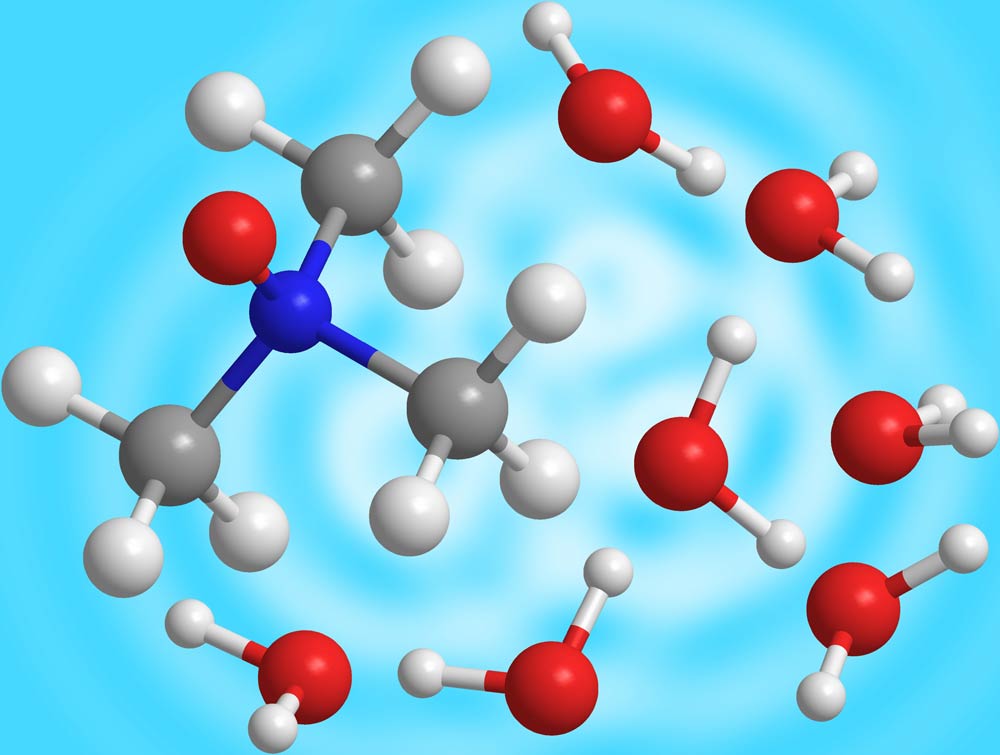Oil Holds Water Transfixed
Many of life’s essential biological processes depend on water and specifically on the repulsion that the oily parts of biomolecules have toward water. But some aspects of the oil-water interaction haven’t been clear. Researchers reporting in the 5 October Physical Review Letters studied water mixed with oily compounds using precisely-timed pulses of infrared light. They showed that part of the shell of water surrounding oily molecules is frozen in place, confirming a controversial model from 60 years ago. The findings could help scientists better understand how water repulsion molds the molecules of life.
Embodied in the maxim “oil and water don’t mix,” the so-called hydrophobic effect creates an apparent attraction between “water-fearing,” or “apolar,” molecules dissolved in water. These compounds cluster to shelter each other from surrounding water and also form into the thin membranes that are the “skin” of all biological cells. Proteins, as well, fold over on themselves to exclude water from their hydrophobic molecular regions. To explain this behavior, scientists often invoke the “iceberg” model–proposed in 1945–which claims that water molecules form a solid shell around apolar molecules. According to the theory, the apolar molecules cluster or fold to minimize the amount of this ice-like layer because the layer is low in entropy, something all systems try to maximize.
But the iceberg model doesn’t agree with all the data. Structural studies have not shown evidence of ice around apolar molecules; instead they show that the hydrogen bonds between water molecules remain loose and slightly disordered like a liquid. In contrast, techniques that measure a solution’s responses to electric and magnetic fields suggest that water molecules are less mobile when mixed with apolar molecules. But these techniques only measure the average properties of a whole sample and therefore cannot easily distinguish where exactly this immobility is occurring.
To better characterize the hydrophobic effect, Yves Rezus and Huib Bakker, both of the Institute for Atomic and Molecular Physics (AMOLF) in the Netherlands, tracked the rotational motion of partially deuterated water–HDO, where one hydrogen is replaced by a heavier deuterium–around apolar molecules. They used ultrafast pump-probe spectroscopy, a “high-speed camera” technique. An initial femtosecond flash from a polarized infrared laser beam excited, or “pumped,” vibrations in oxygen-deuterium (OD) bonds aligned along the beam’s polarization (electric field) direction. After a short delay, a second pulse “probed” the number of excited OD bonds that were vibrating in the parallel and perpendicular directions.
The results showed that a significant fraction of the water molecules rotated after 2.5 picoseconds, while the remaining fraction had yet to rotate after more than 10 picoseconds. The quick rotation rate is consistent with measurements of pure water, implying that some water molecules were far from the apolar molecules. The slower-rotating fraction appeared to be tied up with the apolar molecules, and to confirm this, the researchers showed that the slow fraction increased as they increased the apolar concentration.
“The water molecules around an apolar molecule may not have the structure of ice, but they are moving a lot slower than they would be in the normal liquid state,” Rezus says. Biophysicist Kim Sharp of the University of Pennsylvania considers this the first direct observation of the iceberg model, thus completing a long history of trying to confirm this theory. She does, however, find it somewhat surprising that the authors estimate only a small fraction (roughly 20%) of the surrounding shell of water is immobilized. The remaining puzzle, she says, is how to relate these specific structural changes in water to thermodynamic properties that determine how proteins fold and cell membranes form.
–Michael Schirber
Michael Schirber is a Corresponding Editor for Physics Magazine based in Lyon, France.





